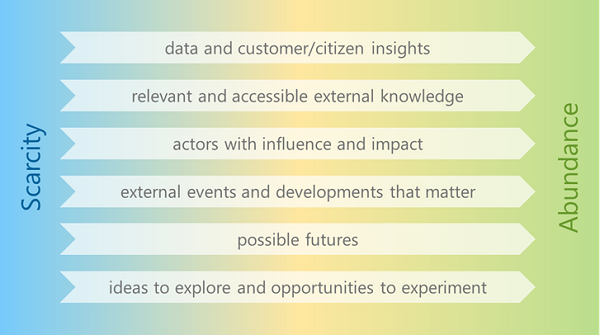How do you achieve an Innovative Learning Organisation?

The work of the public sector is changing quickly to respond to a more complex, interdependent and hard-to-predict world. Are we, and the organisations we work in or with, ready to fully understand that change and convert that new understanding into knowledge and innovations that improves the lives of citizens? We hope to hear from you about your experience to inform our work.

In my last post I wrote about OECD efforts to develop a toolkit to support public servants and their agencies navigate the different tools and methods that might help them at different stages of the innovation process.
The first stage we’re looking at is:
- how agencies identify the opportunities and challenges where innovative responses are most needed or possible
- how agencies learn from their experiences (and those of others) to help them respond in new ways to a changing operating environment.
We’re calling this the “identifying issues” stage and are suggesting that the key focus for this stage should be on building organisations that are capable of capturing, selecting and integrating information and knowledge and transforming it into learning and innovation. We are suggesting that these be called “innovative learning organisations”.
We’re seeking your thoughts about what works, what doesn’t, and whether we’re on the right path.
A changing world means changes for government
Once upon a time, public sector organisations faced an environment where:
- A lot of their work was highly standardised and relatively routine
- There were new challenges and problems, but there were relatively clear lines of accountability and responsibility
- Issues tended to be relatively slow moving, with some time taken before most political issues registered and became dominant issues needing a response
- There was recognition that agencies housed considerable expertise and could be expected to know what could or should be done
- They could plan with a fair degree of confidence.
In more recent times, there’s been a lot of change happening. We can argue over how much change, how fast that change is occurring, and whether the rate of change is accelerating, but one thing is clear: There’s a lot going on, and the amount of information in the world is increasing at a phenomenal rate which is further contributing to change.
That change and that growth in information means that governments cannot rely on things continuing as they have, nor that policies, programs and services can stay the same. Government agencies need to respond, to adjust, to adapt (and sometimes even transform).
With things changing, and sometimes changing very quickly, governments and government agencies need to know:
- What’s happening – what is changing and what does that mean for existing strategies and policies?
- What’s working – what policies, programs and services have been working, and how are they working now?
- What’s not working – what is not working now? What is not working as well as it once did? What has never really worked?
- What might work – what other options are there? What new options might there be that could work better?
- What might happen – what are the trends or developments that might affect what works/what does not work?
Public sector organisations therefore will only be able to successfully identify the challenges that are requiring of innovative responses, and the best opportunities for introducing novel approaches, if they can answer such questions.
Fundamentally then, governments need to be continually learning. Change means that what was known cannot be relied upon to still be true. New learning has to take place.
Of course governments have always needed to learn and have sought to know the answers to these sorts of questions. But when there is significant and ongoing change, it becomes more important to learn answers to these questions faster – or risk spending time and money pursuing strategies based on assumptions or information that will soon be out of date.
Drawing on works such as The Power of Pull and Exponential Organizations, I’d like to suggest that there’s also a pattern that can be seen for why public sector agencies need new approaches for engaging with change, and why learning is now even more important.
In each of the following categories, government agencies are experiencing a change of having to manage a (relative) little, to dealing with a (relative) lot:
- Data availability – there is a growth in government data sets, and a massive growth in externally collected/generated data sets. The Internet of Things and a growing proliferation of sensors likely means that there will be an ever greater abundance of data for all sorts of indicators, whether health, environmental, economic, or social. Where once governments may have had to rely on proxies or estimates, in the near future it is possible that government agencies will be able to draw on unprecedented amounts of real-time data.
- Relevant and accessible external information – once upon a time accessing the knowledge outside of an organisation was slow and potentially difficult. It could be hard to find out who knew what and the means to share information were much slower and laborious to coordinate. In today’s connected world, accessing, aggregating and analysing relevant information from outside of your organisation is vastly easier and less costly.
- Customer / citizen insights – data and information sometimes tell us only so much. Sometimes there’s a need for ‘anecdata’ or insights drawn from the lived experiences of citizens and those using government services. Social media and other real-time feedback mechanisms combined with more sophisticated tools and ethnographic approaches provide a rich source of such insights. At the same time, design thinking is becoming an increasingly important tool for governments. Gaining not just a greater understanding of what people are doing, but also insight into why, is easier than ever before.
- Actors with possible influence or impact – in a connected world, it is easier for individuals and small organisations to have an impact, and possibly global in nature. Where once government agencies might have needed to only think about and engage with a small number of powerful institutional actors, now start-ups and citizen ventures can pop-up very quickly and with significant affect.
- External events or developments that matter – in an interconnected world, events in one field can more easily have cascading ripples across the board. Where once public sector agencies might have limited their monitoring or planning to a small number of situations, now developments from unrelated arenas can often have big impacts on the work of an agency.
- Possible futures – in a world with a small(er) amount of data and information, where there were fewer actors or events that might have a direct impact on the work of an organisation, planning needed to deal with a much narrower range of possible futures or scenarios. In an interconnected world, with rapid changes in information and technology, there is a much wider range of possible futures, and that makes planning and trying to be prepared a lot more complex.
At the same time, some of the same conditions that have resulted in this shift from scarcity to abundance have also meant that organisations are also in a better position to consider and experiment with a lot more ideas. Design thinking, ICT tools, ready availability of data – these and other factors mean that the cost of having and testing an idea (to some extent) is far cheaper than it once might have been. It is now possible to quickly verify an idea, validate and prototype it with relevant people in a way that once would have either been impossible or have taken far more time and resources.
So we have a situation where government agencies are in the process of moving from scarcity to abundance on a range of fronts.
What are the implications of this trend?
I would suggest that it means that public sector organisations are going to be confronted with novel and possibly unexpected situations a lot more frequently, and are therefore going to need to wholeheartedly embrace learning if they wish to be able to respond with novel, innovative solutions in a timely fashion.
In line with what John Seely Brown and John Hagel talk about in The Power of Pull, there needs to be a shift from scalable efficiency (where big organisations focus on becoming more and more efficient, squeezing diminishing benefits out of existing knowledge and strategies) to one of scalable learning (where big organisations focus on learning more and faster, enabling faster and faster improvements in performance). Learning will need to be at the heart of public sector organisations.
An Innovative Learning Organisation
Again, it is worth noting that this is not entirely new for government agencies. Governments have always had to learn and some public sector organisations have been very good at it. But the scale of the change means that learning takes on a new level of priority. It is a shift in thinking from learning as an occasional, albeit consistent activity, to one where learning is a core part of the job and the organisation itself. It is one where learning and innovation are tightly joined.Of course there has also been talk and investigation of learning organisations for some time. For instance, there is the seminal work of Peter Senge in The Fifth Discipline, as well as that of many others including some who have explored what the learning organisation might mean for the public sector. There’s also been a shift towards open innovation, open data and new sorts of partnerships, as well as the discussed shifts in the operating environment, which reflects a broader move towards recognising the learning already happening outside of the organisation.
Given all of this, what then might an innovative learning organisation look like? An organisation where learning is not only valued but is integral to how the organisation and its people work, and where that learning feeds into identifying and understanding where novel responses to problems are needed?
To begin with, and drawing on some of the associated literature that we’ll dig more deeply into later, I suggest that the below are some possible features of innovative learning organisations:
- Learning is seen as part of the job – learning has often been treated as something done in addition to or separate from day-to-day work. It might have been expected that learning would be done through structured learning programs or through specific qualifications. It has much less been seen as a necessary and expected part of people’s jobs.
- Leadership values learning – a natural tendency for many large organisations is to focus on process and results. However, in a fast changing world, process and results will need to be balanced with finding out about change and what will be needed next. Leadership support will need to counter that natural tendency, and to put emphasis on the importance of learning.
- Openness – just as “most of the smartest people work for someone else”, most of the learning that will be of relevance will likely happen outside of the immediate organisation. Public sector agencies are parts of wider systems, and that means there will be lots of learning and experimentation going on elsewhere that could be relevant to you. It might be in a counterpart agency elsewhere in the world, or it might be by an individual citizen – wherever it is, agencies that are open to the lessons of others, that encourage and recognise such contributions are likely to learn far faster than those that see it as an inconvenience or something that is not relevant to them.
- Staff mobility, cross-disciplinary teams and specialisation are balanced – learning will require some mobility and accessing new domains of knowledge. But it will also require significant amounts of specialisation so that new information and lessons can be integrated with previously consolidated knowledge. Learning that does not feed into what has already been learnt (and assimilated by the organisation) risks relearning or misinterpreting new information.
- Staff are empowered – if learning is to be ubiquitous, it means that everyone in the organisation will need to play a role in learning. That will mean that all staff will need to feel empowered to some extent to experiment, to test things, to seek and access new knowledge and to connect with others with relevant shared interests and insights.
- Learning informs the organisation (not just teams or individuals) – for effective learning to occur, learning that really informs organisational decision making, there will need to be systems and processes, and attitudes and behaviours that ensure this learning is shared and available to all areas of the organisation. Some aggregation and integration of these lessons will be required. Knowledge management has traditionally been a challenge for large organisations – it is unlikely to become any less so in an environment where learning is happening all the time.
- There is maintaining as well as learning – An effective innovative learning organisation will need to maintain some sense of what is ‘true’ for it and its work, to continue to have a clear sense of its purpose and its processes and work. While core aspects may be questioned, there will still need to be an integrated sense of the organisation, what it does, and how it works.
- There is unlearning as well as maintaining – new learning means that some old knowledge will have to be unlearnt on occasion. Learning means that new truths will be reached, which means that some old ones will have to be forgotten. Unlearning may be challenging, as it is effectively questioning or invalidating previous knowledge, which may have been strongly assimilated into the work and the identity of the organisation (and those who work in it).
In our first study we will tease out these and other elements and consider further what makes for an innovative learning organisation, building on the ideas and contributions of agencies and individual public servants.
As with much of innovation practice and guidance there is not going to be a specific recipe or set of steps that can be taken by public sector organisations to achieve these sorts of characteristics. Indeed, the original idea of the learning organisation was an ideal model rather than a specific prescription. Yet we will also need to offer some guidance as to what might be useful starting points or tools for organisations.
Tools and Approaches Relevant to an Innovative Learning Organization
So what might be the tools, methods or approaches that could offer the most help agencies and public servants in getting closer to a truly innovative learning organisation? Following on from the earlier discussion, here are some things I suggest may be relevant:
- Clarity of intent – Organisations that can be really clear about their intent will have an advantage as it will be easier for others to know how they can contribute to achieving that intent, and which lessons of theirs might be most relevant to share
- The crowd / complaints / social media – complaints and feedback from the crowd can provide quick insight into problem areas and opportunities for improvement and innovation
- Design thinking – as noted, design thinking can help in understanding the ‘why’ of people’s behaviour and give insight into what underlying issues really are. Design thinking can also be helpful in reframing problems, positing them in a new way that is more amenable to action or intervention
- Systems thinking – by looking at social system components (actors, rules, behaviours) and their interactions, systems thinking can help understand where problems have really come from and also how to integrate possible responses back into a dynamic system
- Testing and validating assumptions – a range of tools might be of use here, including lean start-up methods, business model canvases, as well as behavioural insights and other approaches that can help identify or confront mental models and cognitive biases
- Benchmarking – tracking how other jurisdictions and organisations doing similar work are performing can give quick intelligence about what might be working elsewhere and be worth applying closer to home
- Socialising new technologies/thinking – introducing organisational leadership, staff and partners to new technologies and new ways of thinking can help build a collective sense of where new opportunities might, as well as strengthening understanding that the operating environment is changing and therefore current approaches can and should be open to improvement or even replacement
- Horizon scanning – picking up on weak signals, trends and ‘rehearsing the future’ can help public sector organisations test their assumptions about what might happen, as well as identifying issues early on when they will be easiest to shape and respond to
- Behavioural insights – the field of behavioural insights places a lot of emphasis on measuring results and randomised controlled trials which can assist in ensuring that new insights are matched with hard evidence.
These are some of the tools or steps that might be valuable to an organisation and to public servants trying to identify when and where they need to change their current strategies and introduce novel initiatives that might better meet emerging needs.
But what do you think?
The aim of the toolkit is to be useful to public servants and their organisations. We want to help you in understanding what’s involved in the innovation process and the tools or approaches that might help you get from idea to outcome. We also want to share examples from colleagues from around the world of what’s worked (or not) for them, and look at why, so that you have real life cases that you can see and draw from.
But in order for this work to be of use to you, we need your help. We need to learn from you. As a starting point, here are some questions where I would appreciate your feedback or suggestions (or even doubts or queries):
- Do you think the idea of an innovative learning organisation is helpful for what we have nominated as the beginning of the innovation lifecycle – identifying issues?
- Noting that this is an evolving topic, and one far from perfect, do you think we’re on the right track? Is there something major that we’re missing or that needs further exploration?
- Perhaps most importantly – do you have examples that demonstrate what you think an innovative learning organisation needs to be? Are there any organisations that you can point to that are adept at using the methods outlined above? Or cases that show that other approaches are more likely to be suitable?
I would love to hear from you directly, or you can join in on our discussion groups, either on the OPSI Platform or in our LinkedIn Group, and contribute your thoughts there.
Otherwise, if you would like to be kept informed about what happens with this project and our other projects in public sector innovation, then you can sign up to our mailing list or follow us on Twitter.












